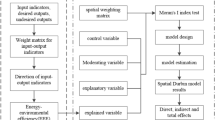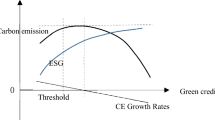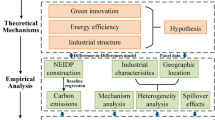Abstract
Carrying out domestic research and development (R&D) activities can improve environmental performance. However, extant studies have not conclusively indicated that R&D activities in all energy fields lead to a reduction in the SO2 intensity. SO2 intensity is defined as the ratio of SO2 emissions to the GDP. Hence, green R&D activities are required. However, the strong heterogeneity between green R&D activities could have distinctive economic consequences. Thus, it is imperative to study the heterogeneity of green R&D activities on SO2 intensity. Moreover, previous studies have ignored regional differences. Although overlooked in the literature, a technology’s adsorptive ability could be a key determinant of the effects of green R&D activities on SO2 intensity. Based on a linear analysis of China’s provincial data over 2000–2016, we show that green R&D activities are instrumental in reducing SO2 intensity. Different green R&D activities have distinct goals and contrasting statistical effects on SO2 intensity. The empirical results show that the impact of green R&D activities on SO2 intensity differs by region. Lastly, it is proposed that green R&D activity effects on SO2 intensity are nonlinear by analysing a technology’s adsorptive ability.

Similar content being viewed by others
Data availability
The datasets used or analysed during the current study are available from the corresponding author on reasonable request.
Change history
07 December 2020
A Correction to this paper has been published: https://doi.org/10.1007/s11356-020-11966-8
Notes
It is worth noting that the names and definitions of ‘clean’ technologies vary from article to article. In most studies, ‘clean technologies’ and ‘green innovations’ correspond to technologies associated with reducing pollution emissions (OECD, World Intellectual Property Organization (WIPO), Wang 2017, Ley et al. 2016).
There is no consensus about the specific dimension and definition of technology absorption ability in current studies. In most researches, the definition of technology absorptive ability was cited by Cohen and Levinthal (1989, 1990, 1994). Therefore, based on Cohen and Levinthal (1989, 1990, 1994) and combined with the research objectives of this paper, it is implied that technology absorption ability refers to a region’s ability to value, acquire, digest, transform, commercially utilise, and recreate new knowledge.
Theoretical analytical framework of this paper is presented in Fig. 1.
Although there are other variables for technology absorptive ability, such as institutional environment and financial development, it is difficult to construct the relevant variables of these in China, because there are some missing data of government expenditure and credit in some provinces since 2000.
WIPO formulated the IPC Green Inventory, which classifies green R&D activities into seven categories: waste management, administrative regulatory or design aspects, energy conservation, transportation, alternative energy production, agriculture or forestry, and nuclear power generation.
Since the data is from the China National Intellectual Property Administration, there is no statistical information such as funds in the database, so the author only discusses green R&D activities according to different purposes.
Only the coefficient of FDI seems different from Table 3, since the effect of FDI on SO2 intensity is unsure from national-level analysis, as discussed in the ‘Literature review’ section.
References
Acemoglu D, Aghion P, Bursztyn L, Hemous D (2009) The environment and directed technical change [D]. Cambridge:Harvard University
Aghion P, Dechezleprêtre A, Hemous D, Martin R, Van Reenen J (2012) Carbon taxes, path dependency and directed technical change: evidence from the auto industry, NBER Working Paper, No.18596
Azimi M, Feng F, Yang Y (2018) Air pollution inequality and its sources in SO2 and NOx emissions among Chinese provinces from 2006 to 2015. Sustainability 10(367):1–25
Bu ML, Li S, Jiang L (2019) Foreign direct investment and energy intensity in China: firm-level evidence. Energy Econ 80:366–376
Chandran, Govindaraju VGR, Tang CF (2013) The dynamic links between CO2 emissions, economic growth and coal consumption in China and India. Appl Energy 104:310–318
Chen H, Yu SW (2017) Emissions and driving forces of primary air pollutants from residential energy consumption in China. China Popul Resour Environ 27(12):40–51
Chen CH, Huang JB, Chang HG, Lei HY (2019) The effects of indigenous R&D activities on China’s energy intensity: a regional perspective. Sci Total Environ 689(NOV.1):1066–1078
Cheng Z, Li L, Liu J (2017) The emissions reduction effect and technical progress effect of environmental regulation policy tools. J Clean Prod 149:191–205 [CrossRef]
Cheng XX, Fan LF, Wang JC (2018) Can energy structure optimization, industrial structure changes, technological improvements, and central and local governance effectively reduce atmospheric pollution in the Beijing-Tianjin-Hebei area in China? Sustainability 10(3):644–660
Cheung KY (2010) Spillover effects of FDI via exports on innovation performance of China’s high-technology industries. J Contemp China 19(65):541–557
Cohen WM, Levinthal DA (1989) Innovation and learning: the two faces of R&D. Econ J 99(3):569596.1
Cohen, W.M., Levinthal, D.A., 1990. Absorptive capacity: a new perspective on learning and innovation. Adm Sci Q, 1990,35(1):128-152
Cohen WM, Levinthal DA (1994) Fortune favors the prepared firm. Manag Sci 40(2):227–251
Cutter B, Deshazo JR (2007) The environmental consequences of decentralizing the decision to decentralize. J Environ Econ Manag 53(1):32–53
Dang JW, Motohashi K (2015) Patent statistics: a good indicator for in China? Patent subsidy program impacts on patent quality. China Econ Rev 35:S1043951X1500053X
Dinda S (2004) Environmental Kuznets curve hypothesis: a survey. Ecol Econ 49(4):431–455
Dong K, Sun R, Hochman G, Li H (2018) Energy intensity and energy conservation potential in China: a regional comparison perspective. Energy 155(15):782–795
Dong YX, Shao S, Zhang Y (2019) Does FDI have energy-saving spillover effect in China? A perspective of energy-biased technical change. J Clean Prod 234:436–450
Driessen PH, Hillebrand B, Kok RAW, Verhallen TMM (2013) Green new product development: the pivotal role of product greenness. IEEE Trans Eng Manag 60(2):315–326
Fussler C, James P (1996) Driving eco a breakthrough discipline for and sustainability. ISBN: 9780273622079
Ghebrihiwet N (2019) FDI technology spillovers in the mining industry: lessons from South Africa’s mining sector. Res Policy 62:463–471
Greene WH (2000) Econometric analysis, 4th edn. Macmillan, London
Hansen BE (1999) Threshold effects in non-dynamic panels: estimation, testing, and inference. J Econom 93(2):345–368
Hao Y, Zhang QX, Zhong M, Li BH (2015) Is there convergence in per capita SO2 emissions in China? An empirical study using city-level panel data. J Clean Prod 108(DEC.1PT.A):944–954
Hassler J, Krusel P, and Olovsson C (2012) Energy-saving technical change. NBER Working Paper 18456
He S, Yan T, Zhou H (2016) Decomposition and spatial clustering analysis of China’s SO2 emissions. Procedia Comput Sci 91:1064–1072
Hoechle D (2007) Robust standard errors for panel regressions with cross-sectional dependence. Stata J 7:281–312.1
Huang JB (2018) Investigating the driving forces of China’s carbon intensity based on a dynamic spatial model. Environ Sci Pollut Res
Huang JB, Chen X (2020) Domestic R&D activities, technology absorption ability, and energy intensity in China. Energy Policy:111184
Huang ZH, Du XJ (2020) Toward green development? Impact of the carbon emissions trading system on local governments’ land supply in energy-intensive industries in China. Sci Total Environ 738. https://doi.org/10.1016/j.scitotenv.2020.139769
Huang JB, Du D, Hao Y (2017) The driving forces of the change in China’s energy intensity: an empirical research using DEA-Malmquist and spatial panel estimations. Econ Model, S0264999316308458.
Huang JB, Luan BJ, Cai XC, Zou H (2019) The role of domestic R&D activities played in carbon intensity: evidence from China. Sci Total Environ
Jiang ZH, Ma J (2019) Inter-relationship among green innovation, environmental pollution and energy consumption. Ecol Econ 35(4):160–167
Jing WM, Zhang L (2014) Environmental regulation, economic opening and China’s industrial green technology progress. Econ Res J
Jude C (2016) Technology spillovers from FDI. Evidence on the intensity of different spillover channels. World Econ 39(12):1947–1973
Kim M, Choi MJ (2019) R&D spillover effects on firms’ export behavior: evidence from South Korea. Appl Econ 51(28):3066–3080. https://doi.org/10.1080/00036846.2018.1564120
Kuang CE, Wen ZY (2019) How does the recessive economy affect green-mechanism analysis and empirical test. Economic Theory and Business Management 06:27–38
Lane PJ, Koka BR, Pathak KS (2006) The reification of absorptive capacity: a critical review and rejuvenation of the construct. Acad Manag Rev 2006 31(4):833–863
Lee K, Lee S (2013) Patterns of technological and evolution in the energy sector: a patent-based approach. Energy Policy 59:415–432
Ley M, Stucki T, Woerter M (2016) The impact of energy prices on green innovation. Energy J 37(1):41–75
Li XB (2012) Behind the recent surge of Chinese patenting: an institutional view. Res Policy 41(1):236–249
Li K, Lin B (2016) Impact of energy technology patents in China: evidence from a panel cointegration and error correction model. Energy Policy 89:214–223
Li L, Bi J, Yang JT, Yan G (2010) Decomposition analysis of regional SO2 emission intensity in China. China Population. Resour Environ
Li Y, Sun LY, Feng TW, Zhu CY (2014) How to reduce energy intensity in China: a regional comparison perspective. Energy Policy 61(oct):513–522
Li R, Fu H, Cui L, Li J, Wu Y, Meng Y, Wang Y, Chen J (2019) The spatiotemporal variation and key factors of SO2 in 336 cities across China. J Clean Prod 210:602–611 [CrossRef]
Liu Y (2015) Demarcating concepts of green. J Fujian Jiangxia Univ 58:67
Liu Q, Wang Q (2015) Re-examine SO2 emissions embodied in China’s exports using multiregional input-output analysis. Ecol Econ 113:39–50 [CrossRef]
Liu QL, Wang Q (2017) How China achieved its 11th five-year plan emissions reduction target: a structural decomposition analysis of industrial SO2 and chemical oxygen demand. Sci Total Environ 574:1104–1116
Liu C, Hong T, Li H, Wang L (2018a) From club convergence of per capita industrial pollutant emissions to industrial transfer effects: an empirical study across 285 cities in China. Energy Policy 121(OCT):300–313
Liu L, Zhou C, Huang J, Hao Y (2018b) The impact of financial development on energy demand: evidence from China. Emerg Mark Financ Trade 54(1-3):269–287
Long XN, Wang J (2015) The cause of patent explosion in China and its mass effect. J World Econ 6:115–143
Panayotou T (1997) Demystifying the environmental Kuznets curve: turning a black box into a policy tool. Environ Dev Econ 2(4):465–484
Pang J, Shi YC, Tao HU, Yan YN, Liang LN (2013) Structural decomposition analysis of pollutants emission change embodied in exports of China. China Environ Sci 33(12):2274–2285
Peng X, Li B (2016) On green industrial transformation in China under different types of environmental regulation. J Financ Econ 42(7):134–145
Peng ZM, Xiang N (2019) Research on the influencing factors of industrial SO2 emission in Hanjiang River eco economic belt prefecture-level cities: based on the perspective of spatial spillover effect. Ecol Econ, 11
Qi SZ, Zhang Q, Wang BB (2017) Market-oriented incentives to the of new energy companies-evidence from venture capital and companies’ patents. China Ind Econ (12):95–112
Rennings K, Ziegler A, Ankele K, Hoffmann E (2006) The influence of different characteristics of the environmental management and auditing scheme on technical environmental and economic performance. Ecol Econ 57(1):45–59
Romer PM (1990) Endogenous technological change. J Polit Econ 98:71–102
Seyoum M, Wu R, Yang L (2015) Technology spillovers from Chinese outward direct investment: the case of Ethiopia. China Econ Rev 33:35–49
Shen LS, Tang Z (2008) The effect of foreign trade on China’s discharge of pollutants. Manag World 6:21–29
Song C, Liu Q, Gu S, Wang Q (2018) The impact of China’s urbanization on economic growth and pollutant emissions: an empirical study based on input-output analysis. J Clean Prod 198(PT.1-1652):1289–1301
Sun HP (2016) Institutional environment, factors distortion and the technical progress. Sci Technol Manag Res 036(021):251–257
Tursun H, Li Z, Liu R, Li Y, Wang X (2015) Contribution weight of engineering technology on pollutant emissions reduction based on IPAT and LMDI methods. Clean Techn Environ Policy 17(1):225–235
Wang BB (2017) Review of environmental policy and technological innovation. Econ Rev:131–149
Wang H, Hu XY (2017) China’s “going-out” strategy and corporate social responsibility: preliminary evidence of a “boomerang effect”. J Contemp China:1–14
Wang BB, Qi SZ (2016) The effect of market-oriented and command-and-control policy tools on emissions reduction-an empirical analysis based on China’s industrial patents data. China Ind Econ
Wang BB, Zhao C (2019) China’s green technological-patent statistics and influencing factors. Journal of China’s Industrial Technology Eonomics 309(7):53–66
Wang Z, Yang Z, Zhang Y, Yin J (2012) Energy technology patents-CO2 emissions nexus: an empirical analysis from China. Energy Policy 42:248–260
Weng ZX, Ma ZY, Ge CZ, Cheng CY (2017) Analysis on urban environmental effect driven by multi-factors of China. China Population, Resources and Environment 27(3):63–73
Wooldridge JM (2002) Econometric analysis of cross section and panel data. MIT Press, Cambridge
Wu LY, Zeng W (2013) Research on the contribution of structure adjustment on SO2 emissions reduction-case study Shijingshan district, Beijing. Procedia Environ Sci 18(Complete):849–855
Xu SC, Zhang WW, Li QB, Zhao B, Wang SX, Long RY (2017) Decomposition analysis of the factors that influence energy related air pollutant emission changes in China using the SDA method. Sustainability 9:1742 [CrossRef]
Xu SC, Li YW, Miao YM (2019) Regional differences in nonlinear impacts of economic growth, export and FDI on air pollutants in China based on provincial panel data. J Clean Prod
Yan HJ (2015) Provincial energy intensity in China: the role of urbanization. Energy Policy 86:635–650
Yang RY, Chen WD (2019) Spatial correlation, influencing factors and environmental supervision on mechanism construction of atmospheric pollution: an empirical study on SO2 emissions in China. Sustainability 11:1742–1755
Yang XL, Zhang AQ (2014) Economic growth and environment degradation: evidence from panel data of prefecture-level cities. Finance Trade Econ 000(001):125–134
Yang X, Wang S, Zhang W, Li J, Zou Y (2016) Impacts of energy consumption, energy structure, and treatment technology on SO2 emissions: a multi-scale LMDI decomposition analysis in China. Appl Energy 184(DEC.15):714–726
Yao L, Liu J, Zhou T, Wang R (2016) An analysis of the driving forces behind pollutant emission reduction in Chinese industry. J Clean Prod 112:1395–1400 [CrossRef]
Ye Q, Zeng G, Dai SQ, Wang FL (2018) Research on the effects of different policy tools on China’s emissions reduction. China Population, Resources and Environment 28(2):115–122
Zahra SA, George G (2002) Absorptive capacity: a review, reconceptualization, and extension. Academy of Management Review 27(2):185–203
Zang ZJ, Zhang H, Liu HF, Wang J, Goetswang KF (2019) Study on the impact of the export of China’s final use products on domestic SO2 emissions. Sustainability 11:5809–5825
Zhao HR, Guo S, Zhao HR (2018) Impacts of GDP, fossil fuel energy consumption, energy consumption intensity, and economic structure on SO2 emissions: a multi-variate panel data model analysis on selected Chinese provinces. Sustainability 10(3):657–677
Zheng Y, Qi J, Chen X (2011) The effect of increasing exports on industrial energy intensity in China. Energy Policy 39(5):2688–2698
Zhou ZM (2019) The spatiotemporal dynamics and socioeconomic factors of SO2 emissions in China: a dynamic spatial econometric design. Atmosphere 10:534–556
Zhou ZM, Ye XY, Ge XY (2017) The impacts of technical progress on sulfur dioxide Kuznets curve in China: a spatial panel data approach. Sustainability 9(4):674–701
Zhou Y, Jiang J, Ye B, Hou B (2019) Green spillovers of outward foreign direct investment on home countries: evidence from China’s province-level data. J Clean Prod 215(APR.1):829–844
Zhu L, Gan Q, Liu Y, Yan Z (2017) The impact of foreign direct investment on SO2 emissions in the Beijing-Tianjin-Hebei region: a spatial econometric analysis. J Clean Prod 166:189–196
Zugravusoilita N (2017) How does foreign direct investment affect pollution? Toward a better understanding of the direct and conditional effects. Environ Resour Econ 66(2):1–46
Author information
Authors and Affiliations
Contributions
All authors contributed to the study conception and design. Material preparation, data collection, and analysis were performed by Yuee Tang, Shuxing Chen, and Junbing Huang. The first draft of the manuscript was written by Yuee Tang, and all authors commented on previous versions of the manuscript. All authors read and approved the final manuscript.
Corresponding author
Ethics declarations
Competing interests
The authors declare that they have no conflict of interest.
Ethical approval
Not applicable.
Consent to participate
Not applicable.
Consent to publish
Not applicable.
Additional information
Responsible Editor: Philippe Garrigues
Publisher’s note
Springer Nature remains neutral with regard to jurisdictional claims in published maps and institutional affiliations.
Rights and permissions
About this article
Cite this article
Tang, Y., Chen, S. & Huang, J. Green research and development activities and SO2 intensity: an analysis for China. Environ Sci Pollut Res 28, 16165–16180 (2021). https://doi.org/10.1007/s11356-020-11669-0
Received:
Accepted:
Published:
Issue Date:
DOI: https://doi.org/10.1007/s11356-020-11669-0




